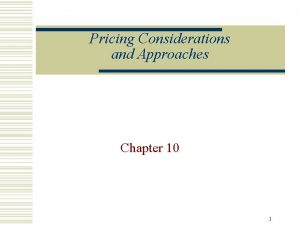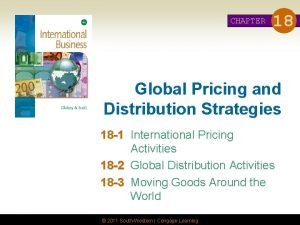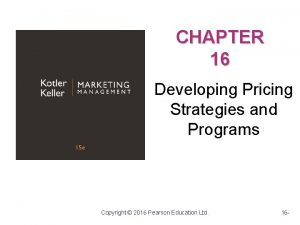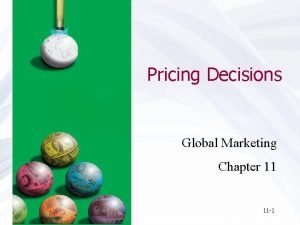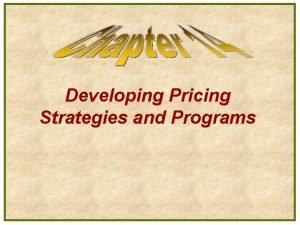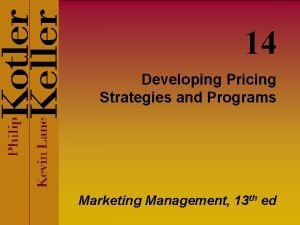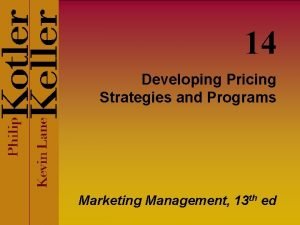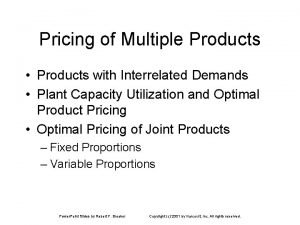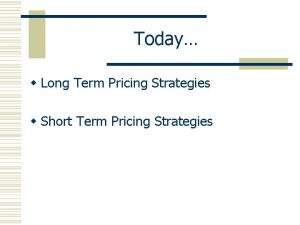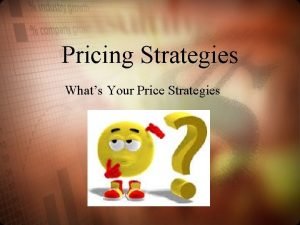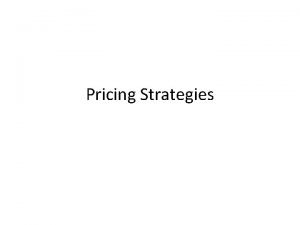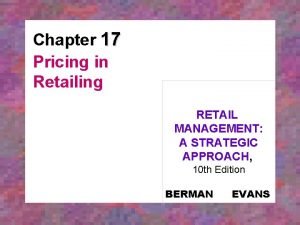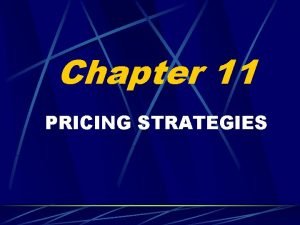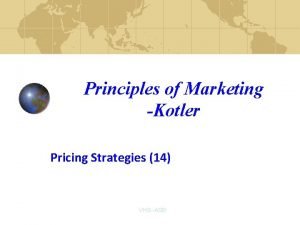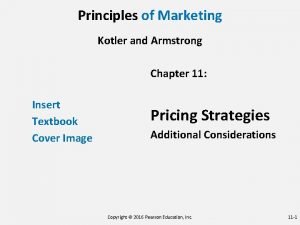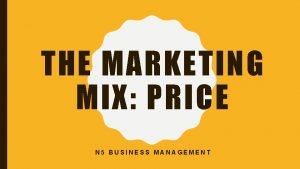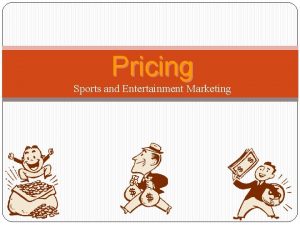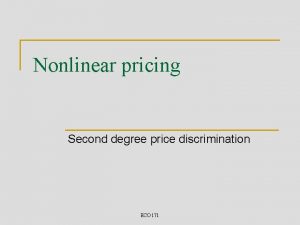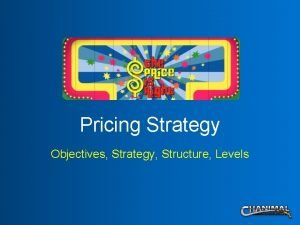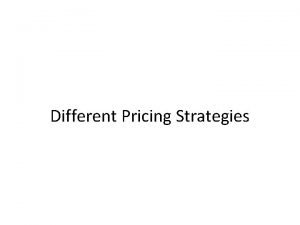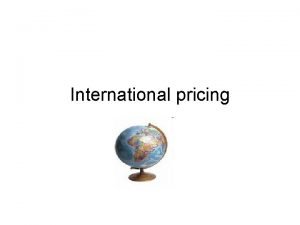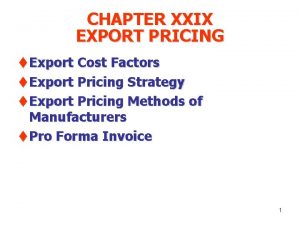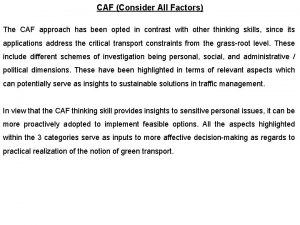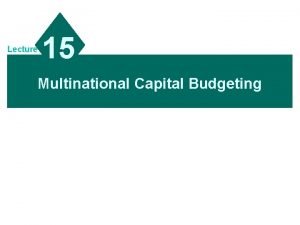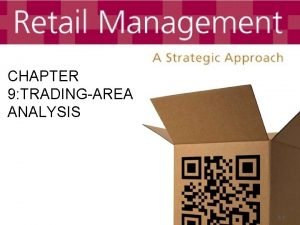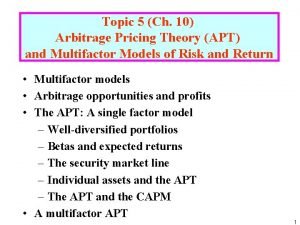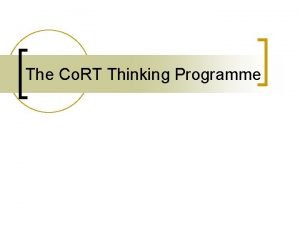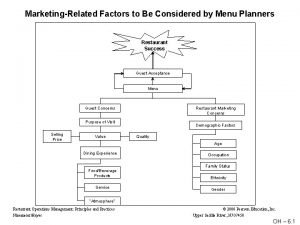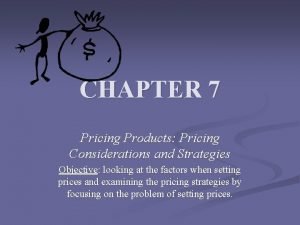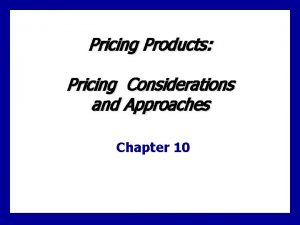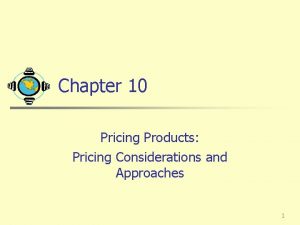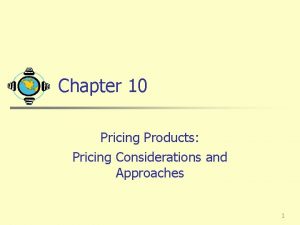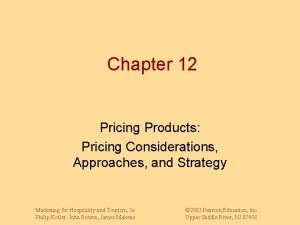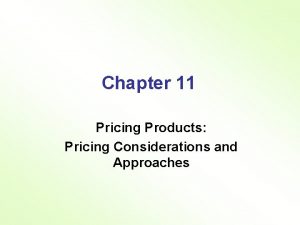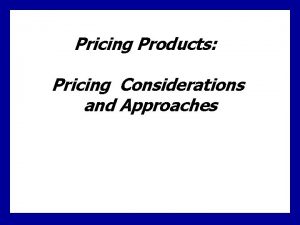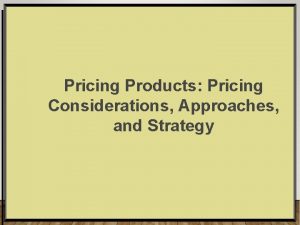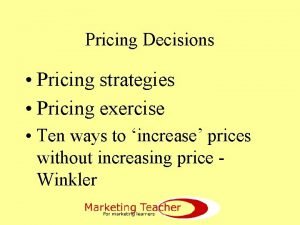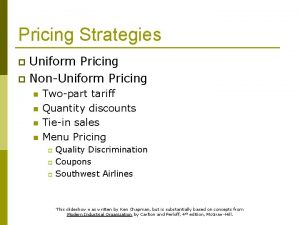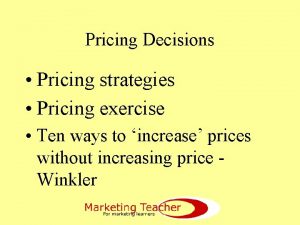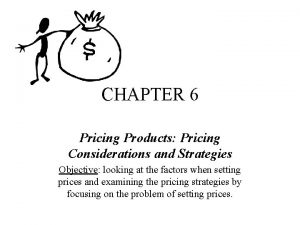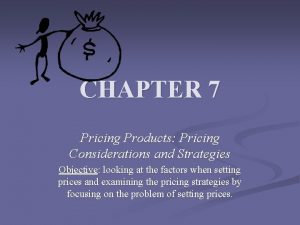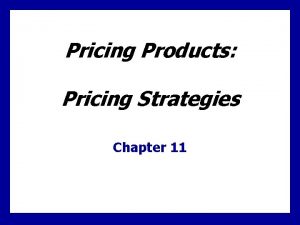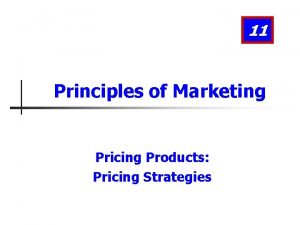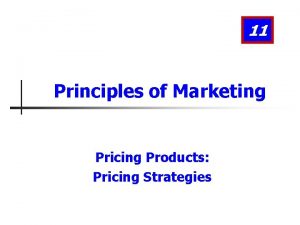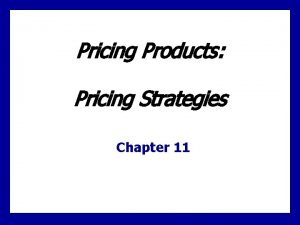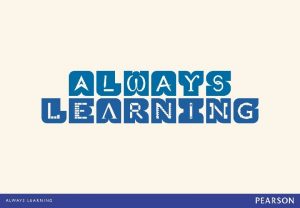PRICING PRODUCTS APPROACHES AND STRATEGIES FACTORS TO CONSIDER

















































- Slides: 49

PRICING PRODUCTS: APPROACHES AND STRATEGIES

FACTORS TO CONSIDER WHEN SETTING PRICES Internal Factors that Affect Pricing Decisions External Factors

INTERNAL FACTORS AFFECTING PRICING DECISIONS Marketing objectives Marketing Mix Strategies Internal factors Costs Organizational considerations

INTERNAL FACTORS AFFECTING PRICING DECISIONS: MARKETING OBJECTIVES Survival Current Profit Maximization Product. Quality Leadership Market. Share Leadership Other Objectives

Survival INTERNAL FACTORS: MARKETING OBJECTIVES • Suffering from too much capacity, slumping economy, changing consumer wants • Characterized by discounting and attempting to salvage cash flow • Profit less important

Current Profit Maximization INTERNAL FACTORS: MARKETING OBJECTIVES • Still focused on short run • Purchase distressed hotel and flip it • Cocnept proven on a smaller level so they can sell to bigger company • Chipotle and Mc. Donalds

Market INTERNAL FACTORS: MARKETING OBJECTIVES Share Leadership • Go after dominant share of the market • Eventually achieve low costs and high long-term profit • Marriott and Australia Gold coast

Product – INTERNAL FACTORS: Quality MARKETING OBJECTIVES Leadership • Charge high prices because of high inherent quality • Constant reinvestment in quality • Paying for a lot more than core product (highly augmented products)

INTERNAL FACTORS AFFECTING PRICING DECISIONS Marketing objectives Marketing Mix Strategies Internal factors Costs Organizational considerations

INTERNAL FACTORS AFFECTING PRICING DECISIONS: MARKETING MIX STRATEGIES • Align with Product, Place, Promotion elements in consistent way • Place: If most rooms at your resort are sold through a wholesaler… • Product: Plan to renovate rooms every few years… • Advertising medium

INTERNAL FACTORS AFFECTING PRICING DECISIONS Marketing objectives Marketing Mix Strategies Internal factors Costs Organizational considerations

INTERNAL FACTORS: COSTS • Set the floor + provide suitable rate of return for investors • Fixed costs • Variable costs • Cost subsidization • Seasonal ski resorts

INTERNAL FACTORS AFFECTING PRICING DECISIONS INTERNAL FACTORS Marketing objectives Marketing Mix Strategies Internal factors Costs Organizational considerations

INTERNAL FACTORS: ORGANIZATIONAL CONSIDERATIONS • Not always the same person or department setting prices • Top management in small company, sales dept, marketing dept • Pricing dept, regional manager, unit manager… • Hotel corporate team establishes pricing and occupancy goals regional management approves individual GMs and Sales manager responsible for achieving them • Revenue Management Dept

FACTORS TO CONSIDER WHEN SETTING PRICES Internal Factors that Affect Pricing Decisions External Factors

EXTERNAL FACTORS AFFECTING PRICING DECISIONS The Nature of Market & Demand Consumer Competition Perceptions of Price & Value

The Nature of Market & Demand PRICE-DEMAND RELATIONSHIP

The Nature of Market & Demand • Relationship between Price and Demand EXTERNAL FACTORS

DEMAND SHIFTS

SUPPLY SHIFTS

EXTERNAL FACTORS AFFECTING PRICE Consumer Perceptions of Price & Value • Perceived value is a function of brand image, product attributes, and price • Awareness of target market and purchase motivation affect price

PRICE ELASTICITY • Measures how responsive demand will be to a change in price • % Change in price = % change in Q demanded / price elasticity of demand • Price Elasticity of Demand= % Change Qd / % Change in Price • 1 = unit elasticity (Qd changes proportionately with price change) http: //www. economicsonline. co. uk/Compet • 0= perfectly inelastic itive_markets/Price_elasticity_of_demand. html

• Income • Availability of substitutes • Time

ELASTICITY EXAMPLE • If we increase the room price from $100 to $120 • And then quantity demanded of rooms goes from 200 to 180 a) What is the Price Elasticity of Demand? Is this elastic or ineleastic) b) Which scenario creates more revenue?

DETERMINANTS OF PRICE ELASTICITY The Product is Unique Buyers are Less Price Sensitive When: Substitute Products are Hard to Find The Product is High in Quality, Prestige or Exclusiveness

FACTORS AFFECTING PRICE SENSITIVITY Unique Value Effect End. Benefit Effect Substitute Awareness Effect Total Expenditure Effect Business Expenditur e Effect Price Quality Effect

APPROACHES TO PRICING Cost-Based Pricing Value-Based Pricing Break-Even Pricing Competition. Based Pricing • The price the company charges is somewhere between one that is too low to produce a profit and one that is too high to produce sufficient demand • Product costs set a floor for the price, while consumer perceptions

Cost. Based Pricing GENERAL APPROACHES TO PRICING • Cost-Plus markup • Wine on menu sold at 300% purchase cost • Cost as a percentage of selling price • 40% food cost means menu item sold at 2. 5 times cost • 30% food cost means menu item sold at 3. 33 times cost • Prime Cost = Labor + Food • Making dessert from scratch may have lower food cost, but labor is high, often not worth it

Cost. Based Pricing GENERAL APPROACHES TO PRICING • Lower the markup as cost increases, dollar value still increases • Wine • Sellers more certain about cost than demand • Simple, common method so less price competition with rivals • Not most effective price because takes little account of Demand

GENERAL APPROACHES TO PRICING Break-Even Pricing


BEP: The volume of output where total cost equals total revenue • Profit (P) = TR – TC • = R x Q – (FC +v x Q) • = Q (R-V) – FC

Example A buffet restaurant wants to make a profit of $200, 000. Its Fixed Costs are $300, 000, Variable cost per meal are $10, and its current Sales price is $20 per meal. What is the Break Even Quantity? How many meals do they need to sell at the current price to reach desired profit? How many meals at $25 selling price?

GENERAL APPROACHES TO PRICING Value-Based Pricing • Willingness to pay • Uses buyers’ perceptions of value as the key to pricing, NOT sellers’ cost • Why a coffee and a piece of pie cost $5 at a family restaurant, $6 at a hotel coffee shop, $10 for room service, $15 at an elegant restaurant • Tradeoff analysis • How much would you pay for a hotel room with and without certain amenities • Helps determine which features add more value than the cost • Holiday Inn designed with this in mind. No frills, no extras

GENERAL APPROACHES TO PRICING Competition. Based Pricing • “Going rate pricing” based on what competitors are charging • Thought to reflect the collective wisdom of the industry

NEW PRODUCT PRICING STRATEGIES Set a low initial price • to penetrate market Prestige quickly and attracting Pricing buyers and market • share Market must be highly Marketprice-sensitive • Penetration. Skimming Economies of scale to reduce cost and profit Pricing • comes with volume Low price bars competition Setting a high price when the market is price-insensitive Make sense when lowering the price will create less revenue Effective short-term policy However, competition will notice the high prices consumers are willing to pay and enter the market, creating

EXISTING PRODUCT PRICING STRATEGIES Product. Bundle Pricing Existing Product Pricing Strategies Price. Adjustment Strategies

Product. Bundle Pricing • Room + meal + entertainment + transportation+… • Promote sale of products customer might normally buy • Benefit 1: Customers have different max prices they are willing to pay, so we can shift the surplus between components • Example: Customer A is willing to pay $280/night for a hotel near Disneyland $350 for two 3 -day passes. Customer B willing to pay $325 /night and $300 for the passes. • If the hotel wants $160/per night, but can get a bulk discount on tickets and offer at $620 package, both customers will buy it even though room price is $20 more than what customer A is willing to pay

Product. Bundle Pricing • Benefit 2: price of core product can be hidden form competition • Avoid price wars • Avoid cheap perception • A Las Vegas Hotel that needs to fill room discounts from $100 to $50 and sells the rooms to an airline • The airline can package the hotel with its airfare from Los Angeles for $299 and the hotel does

PRICE-ADJUSTMENT Discount Pricing and Allowances Discriminatory Pricing Price. Adjustment STRATEGIESStrategies Revenue Management

DISCOUNT PRICING AND ALLOWANCES • Volume discounts: groups, conventions, corporates • Time of Purchase discounts: seasonal, off-peak, early bird, happy hour, late night

DISCRIMINATORY PRICING • Segmentation of the market and pricing differences based on price elasticity characteristics • Works to maximize the amount that each customer pays • Steak dinner menu price $20 x 100 people - (100 x $8) = $1200 profit • Steak dinner menu price $14 x 200 people – VC = $1200 profit • If there are some of the 200 who were willing to pay $20, then losing out on revenue

DISCRIMINATORY PRICING • Early birds • Time sensitive and price sensitive • Coupon • Supersaver: advance purchase and Saturday stayover • Eliminates less price-sensitive business traveler • Geared towards leisure traveler • Fencing • Geography, age, length of stay, corporate, group, loyalty status, usage rate

DISCRIMINATORY PRICING Revenue Management • Involves upselling, cross-selling, and analysis of profit margins and sales volume for each product line • Maximize yield or contribution margin • Rates a hotel will charge and the number of rooms available at each rate based on projected occupancies for a given period • Manage revenue and inventory effectively by pricing differences based on the elasticity of demand for selected segments

DISCRIMINATORY PRICING • -Booking pattern data -Market segment demand patterns -Overbooking policy -Internal and external information systems -Ability to fence segments

DISCRIMINATORY PRICING Revenue Management • Rev. PAR • Revenue Per Available Room • Considers occupancy and average rate • 100 -room hotel that sold 60 rooms at avg rate of $200 • 60/100 x $200 = $120 • Useful for gauging performance across brands, competition • Rev. PASH • Revenue Per Available Seat Hour • Maximizing table seating configurations

PSYCHOLOGICAL PRICING Promotional Pricing Temporary Psychological Pricing Value Pricing Permanent EDLP

PRICE CHANGES Initiating Price Changes Price Cuts Price Increases

 Pricing considerations and approaches
Pricing considerations and approaches General pricing approaches
General pricing approaches Pricing approaches
Pricing approaches Pricing and distribution strategies
Pricing and distribution strategies Developing pricing strategies and programs ppt
Developing pricing strategies and programs ppt Global pricing objectives and strategies
Global pricing objectives and strategies Segmented pricing
Segmented pricing Developing pricing strategies and programs
Developing pricing strategies and programs Developing pricing strategies and programs
Developing pricing strategies and programs Functional product
Functional product Multiple product pricing
Multiple product pricing Short term pricing strategies
Short term pricing strategies Product mix pricing strategies
Product mix pricing strategies Chapter 26 pricing strategies answer key
Chapter 26 pricing strategies answer key What is differential pricing strategy
What is differential pricing strategy Pricing in retailing
Pricing in retailing Segmented pricing
Segmented pricing Kvi pricing strategy
Kvi pricing strategy Kotler pricing strategies
Kotler pricing strategies Captive pricing
Captive pricing Chapter 26 pricing strategies
Chapter 26 pricing strategies 5 marketing mix
5 marketing mix Deposit pricing strategies
Deposit pricing strategies 4 p's starbucks
4 p's starbucks Entertainment pricing strategies
Entertainment pricing strategies 171
171 Price fences marketing
Price fences marketing Pricing strategies in marketing
Pricing strategies in marketing Pricing strategies definition
Pricing strategies definition Contribution pricing
Contribution pricing International pricing strategies
International pricing strategies Factors affecting export pricing
Factors affecting export pricing Advantages of labour saving devices in the kitchen
Advantages of labour saving devices in the kitchen Consider all factors
Consider all factors Disadvantages of rsa retail savings bonds
Disadvantages of rsa retail savings bonds Wjec hospitality and catering unit 2 examples
Wjec hospitality and catering unit 2 examples Factors to consider in multinational capital budgeting
Factors to consider in multinational capital budgeting Trade area analysis methods
Trade area analysis methods Apt model
Apt model Consider all factors de bono
Consider all factors de bono Factors to consider in menu planning
Factors to consider in menu planning Discount and allowance pricing strategy
Discount and allowance pricing strategy What factors did you consider in acquiring territories?
What factors did you consider in acquiring territories? Factors to consider before going global
Factors to consider before going global Approaches to develop social factors
Approaches to develop social factors Describe an approach to develop the physical factor
Describe an approach to develop the physical factor Approaches for mental factor
Approaches for mental factor Approaches to develop emotional factors
Approaches to develop emotional factors Approaches to develop emotional factors
Approaches to develop emotional factors Mental factors pe
Mental factors pe

